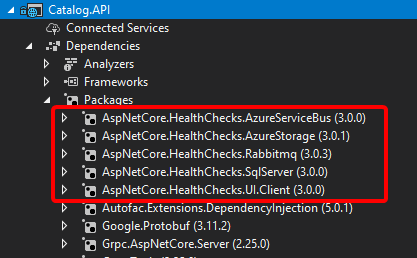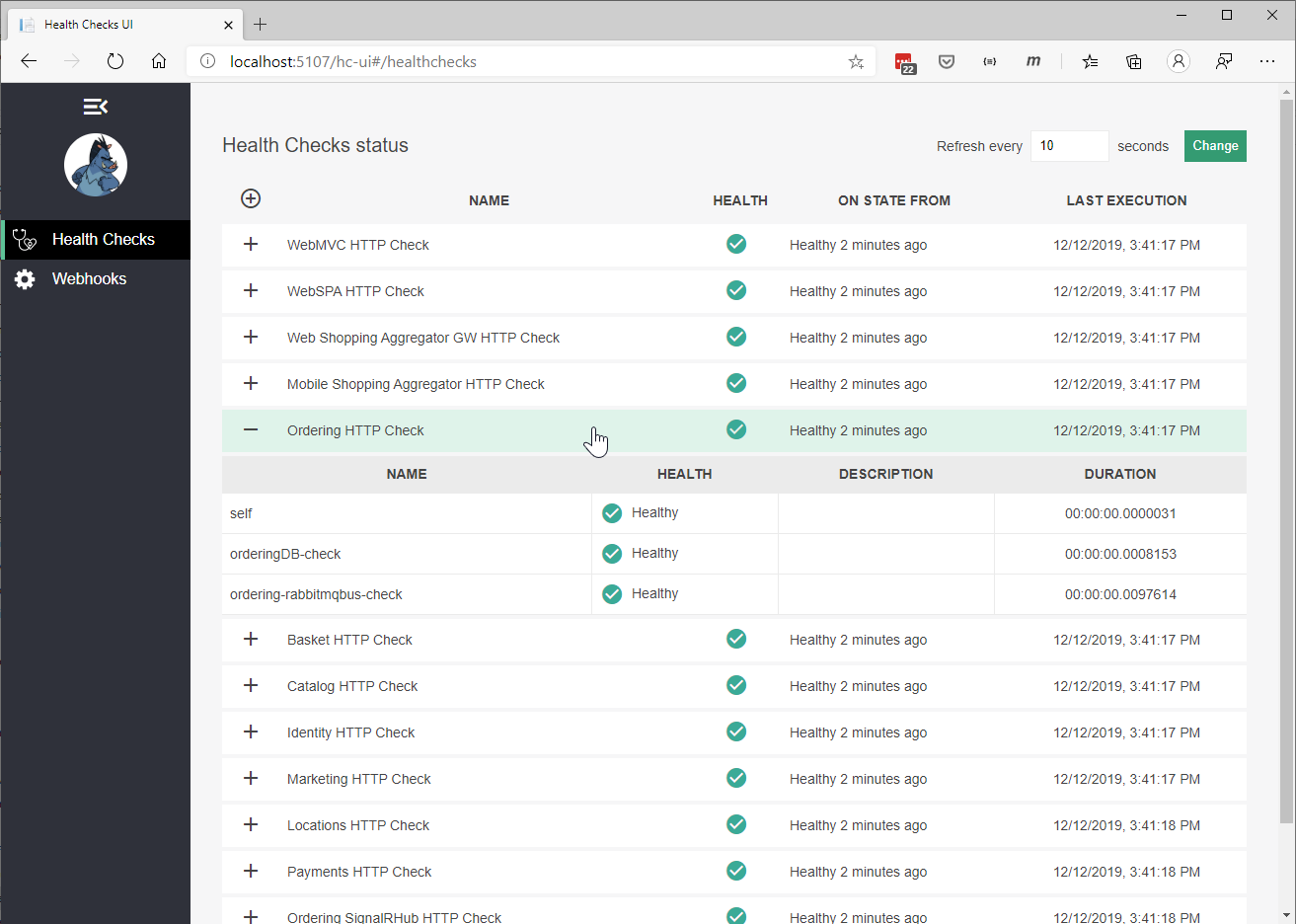Health monitoring
Tip
This content is an excerpt from the eBook, .NET Microservices Architecture for Containerized .NET Applications, available on .NET Docs or as a free downloadable PDF that can be read offline.

Health monitoring can allow near-real-time information about the state of your containers and microservices. Health monitoring is critical to multiple aspects of operating microservices and is especially important when orchestrators perform partial application upgrades in phases, as explained later.
Microservices-based applications often use heartbeats or health checks to enable their performance monitors, schedulers, and orchestrators to keep track of the multitude of services. If services cannot send some sort of "I'm alive" signal, either on demand or on a schedule, your application might face risks when you deploy updates, or it might just detect failures too late and not be able to stop cascading failures that can end up in major outages.
In the typical model, services send reports about their status, and that information is aggregated to provide an overall view of the state of health of your application. If you're using an orchestrator, you can provide health information to your orchestrator's cluster, so that the cluster can act accordingly. If you invest in high-quality health reporting that's customized for your application, you can detect and fix issues for your running application much more easily.
Implement health checks in ASP.NET Core services
When developing an ASP.NET Core microservice or web application, you can use the built-in health checks feature that was released in ASP .NET Core 2.2 (Microsoft.Extensions.Diagnostics.HealthChecks). Like many ASP.NET Core features, health checks come with a set of services and a middleware.
Health check services and middleware are easy to use and provide capabilities that let you validate if any external resource needed for your application (like a SQL Server database or a remote API) is working properly. When you use this feature, you can also decide what it means that the resource is healthy, as we explain later.
To use this feature effectively, you need to first configure services in your microservices. Second, you need a front-end application that queries for the health reports. That front-end application could be a custom reporting application, or it could be an orchestrator itself that can react accordingly to the health states.
Use the HealthChecks feature in your back-end ASP.NET microservices
In this section, you'll learn how to implement the HealthChecks feature in a sample ASP.NET Core 8.0 Web API application when using the Microsoft.Extensions.Diagnostics.HealthChecks package. The Implementation of this feature in a large-scale microservices like the eShopOnContainers is explained in the next section.
To begin, you need to define what constitutes a healthy status for each microservice. In the sample application, we define the microservice is healthy if its API is accessible via HTTP and its related SQL Server database is also available.
In .NET 8, with the built-in APIs, you can configure the services, add a Health Check for the microservice and its dependent SQL Server database in this way:
// Program.cs from .NET 8 Web API sample
//...
// Registers required services for health checks
builder.Services.AddHealthChecks()
// Add a health check for a SQL Server database
.AddCheck(
"OrderingDB-check",
new SqlConnectionHealthCheck(builder.Configuration["ConnectionString"]),
HealthStatus.Unhealthy,
new string[] { "orderingdb" });
In the previous code, the services.AddHealthChecks() method configures a basic HTTP check that returns a status code 200 with "Healthy". Further, the AddCheck() extension method configures a custom SqlConnectionHealthCheck that checks the related SQL Database's health.
The AddCheck() method adds a new health check with a specified name and the implementation of type IHealthCheck. You can add multiple Health Checks using AddCheck method, so a microservice won't provide a "healthy" status until all its checks are healthy.
SqlConnectionHealthCheck is a custom class that implements IHealthCheck, which takes a connection string as a constructor parameter and executes a simple query to check if the connection to the SQL database is successful. It returns HealthCheckResult.Healthy() if the query was executed successfully and a FailureStatus with the actual exception when it fails.
// Sample SQL Connection Health Check
public class SqlConnectionHealthCheck : IHealthCheck
{
private const string DefaultTestQuery = "Select 1";
public string ConnectionString { get; }
public string TestQuery { get; }
public SqlConnectionHealthCheck(string connectionString)
: this(connectionString, testQuery: DefaultTestQuery)
{
}
public SqlConnectionHealthCheck(string connectionString, string testQuery)
{
ConnectionString = connectionString ?? throw new ArgumentNullException(nameof(connectionString));
TestQuery = testQuery;
}
public async Task<HealthCheckResult> CheckHealthAsync(HealthCheckContext context, CancellationToken cancellationToken = default(CancellationToken))
{
using (var connection = new SqlConnection(ConnectionString))
{
try
{
await connection.OpenAsync(cancellationToken);
if (TestQuery != null)
{
var command = connection.CreateCommand();
command.CommandText = TestQuery;
await command.ExecuteNonQueryAsync(cancellationToken);
}
}
catch (DbException ex)
{
return new HealthCheckResult(status: context.Registration.FailureStatus, exception: ex);
}
}
return HealthCheckResult.Healthy();
}
}
Important
Microsoft recommends that you use the most secure authentication flow available. If you're connecting to Azure SQL, Managed Identities for Azure resources is the recommended authentication method.
Note that in the previous code, Select 1 is the query used to check the Health of the database. To monitor the availability of your microservices, orchestrators like Kubernetes periodically perform health checks by sending requests to test the microservices. It's important to keep your database queries efficient so that these operations are quick and don’t result in a higher utilization of resources.
Finally, add a middleware that responds to the url path /hc:
// Program.cs from .NET 8 Web Api sample
app.MapHealthChecks("/hc");
When the endpoint <yourmicroservice>/hc is invoked, it runs all the health checks that are configured in the AddHealthChecks() method in the Startup class and shows the result.
HealthChecks implementation in eShopOnContainers
Microservices in eShopOnContainers rely on multiple services to perform its task. For example, the Catalog.API microservice from eShopOnContainers depends on many services, such as Azure Blob Storage, SQL Server, and RabbitMQ. Therefore, it has several health checks added using the AddCheck() method. For every dependent service, a custom IHealthCheck implementation that defines its respective health status would need to be added.
The open-source project AspNetCore.Diagnostics.HealthChecks solves this problem by providing custom health check implementations for each of these enterprise services, that are built on top of .NET 8. Each health check is available as an individual NuGet package that can be easily added to the project. eShopOnContainers uses them extensively in all its microservices.
For instance, in the Catalog.API microservice, the following NuGet packages were added:

Figure 8-7. Custom Health Checks implemented in Catalog.API using AspNetCore.Diagnostics.HealthChecks
In the following code, the health check implementations are added for each dependent service and then the middleware is configured:
// Extension method from Catalog.api microservice
//
public static IServiceCollection AddCustomHealthCheck(this IServiceCollection services, IConfiguration configuration)
{
var accountName = configuration.GetValue<string>("AzureStorageAccountName");
var accountKey = configuration.GetValue<string>("AzureStorageAccountKey");
var hcBuilder = services.AddHealthChecks();
hcBuilder
.AddSqlServer(
configuration["ConnectionString"],
name: "CatalogDB-check",
tags: new string[] { "catalogdb" });
if (!string.IsNullOrEmpty(accountName) && !string.IsNullOrEmpty(accountKey))
{
hcBuilder
.AddAzureBlobStorage(
$"DefaultEndpointsProtocol=https;AccountName={accountName};AccountKey={accountKey};EndpointSuffix=core.windows.net",
name: "catalog-storage-check",
tags: new string[] { "catalogstorage" });
}
if (configuration.GetValue<bool>("AzureServiceBusEnabled"))
{
hcBuilder
.AddAzureServiceBusTopic(
configuration["EventBusConnection"],
topicName: "eshop_event_bus",
name: "catalog-servicebus-check",
tags: new string[] { "servicebus" });
}
else
{
hcBuilder
.AddRabbitMQ(
$"amqp://{configuration["EventBusConnection"]}",
name: "catalog-rabbitmqbus-check",
tags: new string[] { "rabbitmqbus" });
}
return services;
}
Finally, add the HealthCheck middleware to listen to “/hc” endpoint:
// HealthCheck middleware
app.UseHealthChecks("/hc", new HealthCheckOptions()
{
Predicate = _ => true,
ResponseWriter = UIResponseWriter.WriteHealthCheckUIResponse
});
Query your microservices to report about their health status
When you've configured health checks as described in this article and you have the microservice running in Docker, you can directly check from a browser if it's healthy. You have to publish the container port in the Docker host, so you can access the container through the external Docker host IP or through host.docker.internal, as shown in figure 8-8.

Figure 8-8. Checking health status of a single service from a browser
In that test, you can see that the Catalog.API microservice (running on port 5101) is healthy, returning HTTP status 200 and status information in JSON. The service also checked the health of its SQL Server database dependency and RabbitMQ, so the health check reported itself as healthy.
Use watchdogs
A watchdog is a separate service that can watch health and load across services, and report health about the microservices by querying with the HealthChecks library introduced earlier. This can help prevent errors that would not be detected based on the view of a single service. Watchdogs also are a good place to host code that can perform remediation actions for known conditions without user interaction.
The eShopOnContainers sample contains a web page that displays sample health check reports, as shown in Figure 8-9. This is the simplest watchdog you could have since it only shows the state of the microservices and web applications in eShopOnContainers. Usually a watchdog also takes actions when it detects unhealthy states.
Fortunately, AspNetCore.Diagnostics.HealthChecks also provides AspNetCore.HealthChecks.UI NuGet package that can be used to display the health check results from the configured URIs.

Figure 8-9. Sample health check report in eShopOnContainers
In summary, this watchdog service queries each microservice's "/hc" endpoint. This will execute all the health checks defined within it and return an overall health state depending on all those checks. The HealthChecksUI is easy to consume with a few configuration entries and two lines of code that needs to be added into the Startup.cs of the watchdog service.
Sample configuration file for health check UI:
// Configuration
{
"HealthChecksUI": {
"HealthChecks": [
{
"Name": "Ordering HTTP Check",
"Uri": "http://host.docker.internal:5102/hc"
},
{
"Name": "Ordering HTTP Background Check",
"Uri": "http://host.docker.internal:5111/hc"
},
//...
]}
}
Program.cs file that adds HealthChecksUI:
// Program.cs from WebStatus(Watch Dog) service
//
// Registers required services for health checks
builder.Services.AddHealthChecksUI();
// build the app, register other middleware
app.UseHealthChecksUI(config => config.UIPath = "/hc-ui");
Health checks when using orchestrators
To monitor the availability of your microservices, orchestrators like Kubernetes and Service Fabric periodically perform health checks by sending requests to test the microservices. When an orchestrator determines that a service/container is unhealthy, it stops routing requests to that instance. It also usually creates a new instance of that container.
For instance, most orchestrators can use health checks to manage zero-downtime deployments. Only when the status of a service/container changes to healthy will the orchestrator start routing traffic to service/container instances.
Health monitoring is especially important when an orchestrator performs an application upgrade. Some orchestrators (like Azure Service Fabric) update services in phases—for example, they might update one-fifth of the cluster surface for each application upgrade. The set of nodes that's upgraded at the same time is referred to as an upgrade domain. After each upgrade domain has been upgraded and is available to users, that upgrade domain must pass health checks before the deployment moves to the next upgrade domain.
Another aspect of service health is reporting metrics from the service. This is an advanced capability of the health model of some orchestrators, like Service Fabric. Metrics are important when using an orchestrator because they are used to balance resource usage. Metrics also can be an indicator of system health. For example, you might have an application that has many microservices, and each instance reports a requests-per-second (RPS) metric. If one service is using more resources (memory, processor, etc.) than another service, the orchestrator could move service instances around in the cluster to try to maintain even resource utilization.
Note that Azure Service Fabric provides its own Health Monitoring model, which is more advanced than simple health checks.
Advanced monitoring: visualization, analysis, and alerts
The final part of monitoring is visualizing the event stream, reporting on service performance, and alerting when an issue is detected. You can use different solutions for this aspect of monitoring.
You can use simple custom applications showing the state of your services, like the custom page shown when explaining the AspNetCore.Diagnostics.HealthChecks. Or you could use more advanced tools like Azure Monitor to raise alerts based on the stream of events.
Finally, if you're storing all the event streams, you can use Microsoft Power BI or other solutions like Kibana or Splunk to visualize the data.
Additional resources
HealthChecks and HealthChecks UI for ASP.NET Core
https://github.com/Xabaril/AspNetCore.Diagnostics.HealthChecksIntroduction to Service Fabric health monitoring
https://learn.microsoft.com/azure/service-fabric/service-fabric-health-introductionAzure Monitor
https://azure.microsoft.com/services/monitor/
